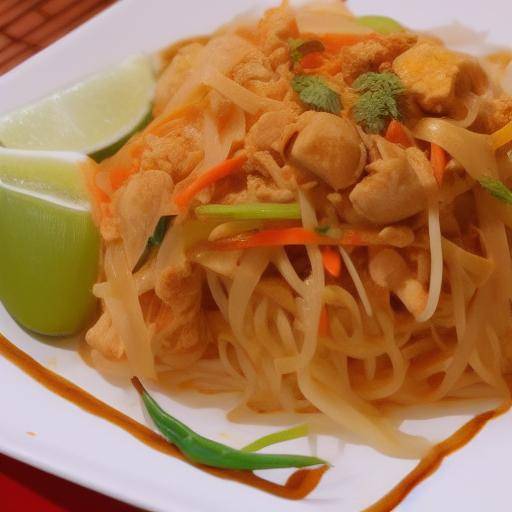
Thai cuisine is internationally recognized for its diversity of flavours, fresh ingredients and emblematic dishes that have conquered palates all over the world. One of these iconic dishes is the delicious pad thai, a street dish that has transcended the borders of Thailand to become a popular dish and appreciated throughout the globe.
Introduction
In this article, we will explore the history and preparation of the pad thai, a dish that not only delights the palate, but also reveals Thailand's rich history and culture. From its humble beginnings in the bustling streets of Thailand to its current status as a global culinary treasure, we will discover the secrets behind this amazing dish.
History and Background
To really understand the significance and importance of the pad thai, it is crucial to get into its history and understand how this dish has shaped Thailand's culinary identity.
The history of the pad thai goes back to the streets of Thailand in the early twentieth century. During that time, Thailand experienced major political and social changes that impacted the way food was prepared and consumed throughout the country. In the midst of this context, Pad thai was born as a creative response to rice shortages, the basic food of the time. The street vendors improvised this dish by merging rice noodles with local ingredients such as tofu, shrimp, peanuts, egg and soybeans, giving rise to what we know today as pad thai.
Decades later, the pad thai has become a symbol of Thai gastronomy, transcending national borders to captivate food lovers around the world. Its popularity has flourished in the street markets of Thailand, the luxurious global restaurants and home cooking, consolidating itself as an emblematic dish both in Thailand and in the international gastronomic scene.
In-depth Analysis
The pad thai is not only a delicious dish, but also offers a series of both gastronomic and cultural benefits. Its unique combination of flavors, textures and aromas makes it a very attractive dish for the diners of different tastes and cultures. In addition, its versatility allows a wide range of variations to adapt to different dietary preferences, from vegans to seafood lovers.
One of the greatest advantages of the pad thai is its perfect balance between the five fundamental flavors: sweet, salty, spicy, acid and bitter. This complex combination of flavors is the result of careful selection and harmonization of key ingredients, making it a highly satisfying and captivating dish for the palate.
Despite its popularity, the pad thai is not without challenges, especially in a constantly evolving global culinary context. The authenticity and preservation of traditional recipes are critical aspects that face challenges to the influence of modern cuisine and international culinary trends. It is crucial to balance the celebration of the evolution of the dish with the preservation of its historical roots to ensure that the pad thai remains a representative emblem of Thai cuisine.
Comprehensive Examination
The pad thai has a wide range of culinary applications that goes beyond its traditional presentation as a main dish. Its versatility makes it an invaluable ingredient to experience in the kitchen and create new culinary interpretations. From noodles to spring rolls, the pad thai serves as an inspiring base for a variety of innovative culinary creations.
In addition, the pad thai provides a window to Thailand's rich history and culture. Each pad thai bite is an opportunity to connect with the culinary traditions rooted in the country's history. This dish not only satisfies elapetito, but also opens doors to the exploration of Thai culinary diversity and cultural heritage.
Comparative analysis
When comparing the pad thai with other traditional Thai dishes, it is evident that it has distinctive features that stand out as an icon of the country's gastronomy. Unlike dishes such as Thai curry or tom yum, the pad thai stands out for its relative simplicity and focus on highlighting the freshness of its main ingredients. This distinction makes it a popular choice for both locals and foreign visitors who want to enjoy Thai cuisine in an accessible and delicious way.
When discussed in the context of Thailand ' s history, the pad thai reflects the ingenuity and creativity of the Thai people in the face of changing challenges. Its ability to transform basic ingredients into an emblematic dish is a testimony to the ability of Thai culture to adapt and thrive in times of change.
Practical Tips and Accessible Tips
For those who want to enter the preparation of the pad thai in their own kitchens, it is essential to understand the foundations that make this dish so special. The quality and freshness of the ingredients are crucial, as each component contributes significantly to the final taste of the dish. In addition, mastering the art of balancing the key flavors and controlling the texture of the noodles are essential skills to achieve an authentic and delicious padai.
Here are some practical tips for the successful preparation of the pad thai:
- Use high quality rice noodles to get the right texture.
- Adjust the amount of tamarindo sauce, palm sugar and lime juice to achieve the right balance of flavors.
- Incorporate fried tofu, fresh shrimp or chicken to customize your pad thai version.
- Decorate with soybean shoots, crushed peanuts and fresh cilantro for an authentic presentation.
Following these practical advices, you can successfully recreate the essence of this iconic dish in the comfort of your home and delight your diners with an authentic Thai culinary experience.
Conclusion
In conclusion, the pad thai goes beyond simply being a delicious dish; it is a symbol of Thailand's rich culinary and cultural heritage. From its humble origins as a creative response to rice shortages to its current status as a globally appreciated dish, the pad thai embodies the essence of culinary innovation and Thailand's rich history.
In exploring its history, benefits, applications and challenges, we have unraveled the nuances that make Pad thai a culinary treasure worthy of celebration and preservation. The preparation and enjoyment of this dish is not only a memorable gastronomic experience, but also a tribute to the rich culinary and cultural diversity of Thailand.
FAQs
What is the origin of the pad thai?
The pad thai originated in Thailand in the early twentieth century as a response to rice shortages and has evolved to become an emblematic dish of Thai gastronomy.
What makes the pad thai so special?
The balance of sweet, salty, acid, spicy and bitter flavors, together with the versatility of ingredients, makes it special and attractive for a wide variety of diners.
How can I adapt the pad thai to my dietary preferences?
The pad thai is highly adaptable and can be prepared with ingredients that fit different preferences, including vegan, vegetarian or animal protein options.
What are the keys to preparing an authentic pad thai?
The use of fresh ingredients and the correct proportion of flavors are fundamental. Mastering the salsa preparation technique and cooking of the noodles are essential aspects to achieve a true taste of pad thai.
What are some popular variants of the pad thai?
Some popular variants include the pad thai with shrimp, chicken, tofu, or vegetables, as well as adaptations for vegetarian and vegan diets.
What is the importance of pad thai in Thai culture?
The pad thai is not only an emblematic dish, but also reflects the creativity and ingenuity of the Thai people. It also represents the spirit of adaptation and evolution of Thai cuisine over time.
Is the pad thai always spicy?
The spicy level may vary depending on the preference of the comensal or the specific recipe. However, the balance between the five fundamental flavors is essential, and the spicy component can be adjusted according to personal taste.
In exploring these frequently asked questions, we deepen the understanding of the history, preparation and cultural importance of the pad thai, providing a complete overview of this iconic dish of Thai cuisine.
In short, the pad thai is much more than a delicious dish; it is a symbol of Thailand's rich culinary and cultural heritage. From its modest origins to its global status, the pad thai is a culinary treasure that illustrates the creativity, adaptability and rich history of Thailand through its unique flavors and its deep connection to the culinary identity of the country.














